Provenance of Late Paleozoic-Mesozoic Sandstones, Taimyr Peninsula, the Arctic
Abstract
:1. Introduction

2. Geological Setting
3. Samples and Methods
| Sample No. | Location | Formation | Petrography | Heavy mineral analysis | Detrital zircon geochronology |
|---|---|---|---|---|---|
| VP10-12 | Southeastern Taimyr | Late Permian Baykurskaya | X | X | X |
| VP10-14 | Southeastern Taimyr | Early Permian Sokolinskaya | X | X | X |
| VP10-25 | Southeastern Taimyr | Late Carb to Early Permian Turozovskya | X | X | X |
| RAS98-8 | Near Taimyr Lake | Early Permian Byrrangskaya | X | X | X |
| RAS98-9 | Near Taimyr Lake | Early Permian Byrrangskaya | X | X | – |
| RAS98-32 | Near Taimyr Lake | Early Permian Byrrangskaya | X | X | – |
| RAS98-23 | Near Taimyr Lake | Late Carb to Early Permian Turozovskya | X | X | – |
| T99-26 | Northern Taimyr | Early Cretaceous Unnamed | X | X | X |
| T99-32 | Northern Taimyr | Early Cretaceous Unnamed | X | X | – |
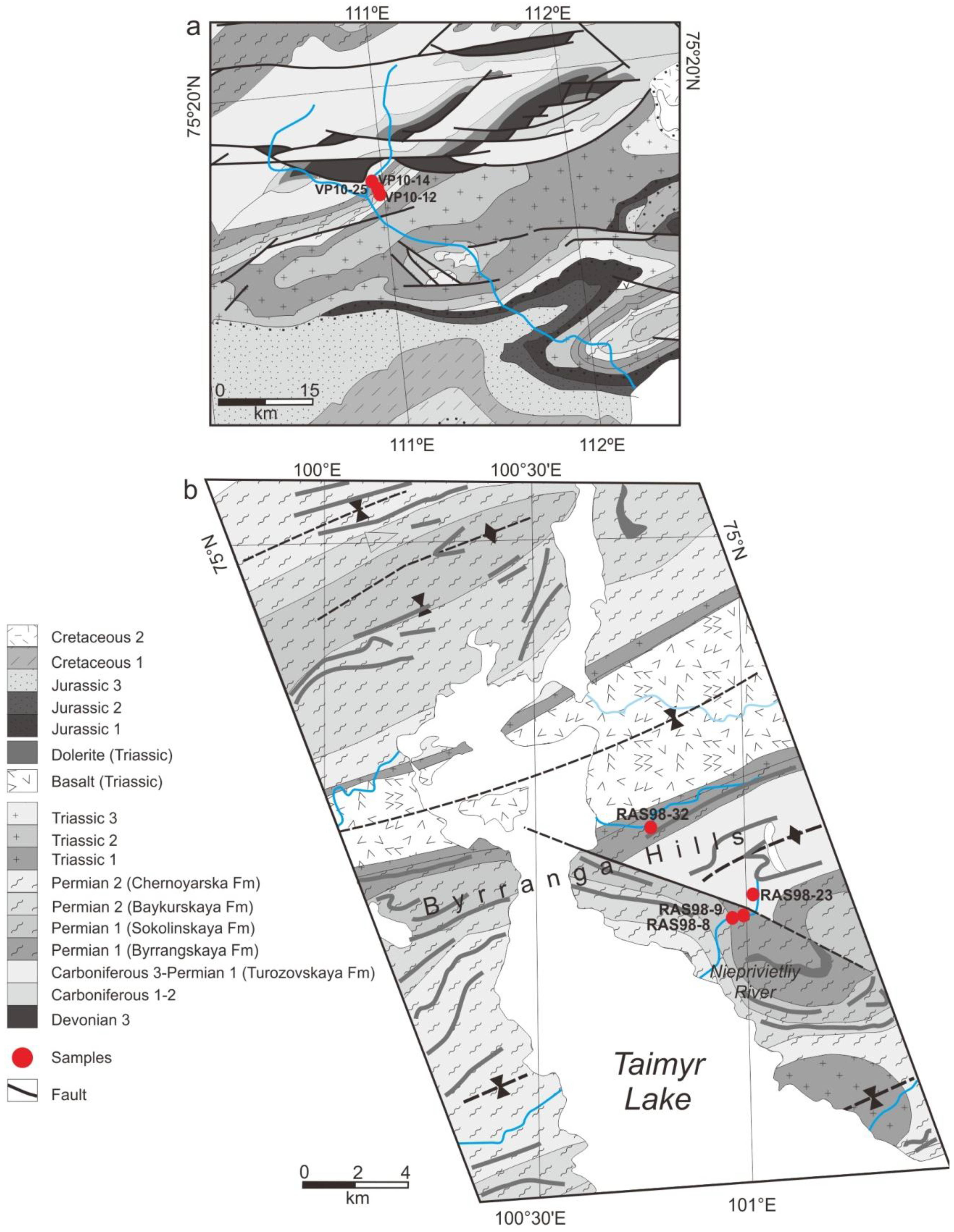
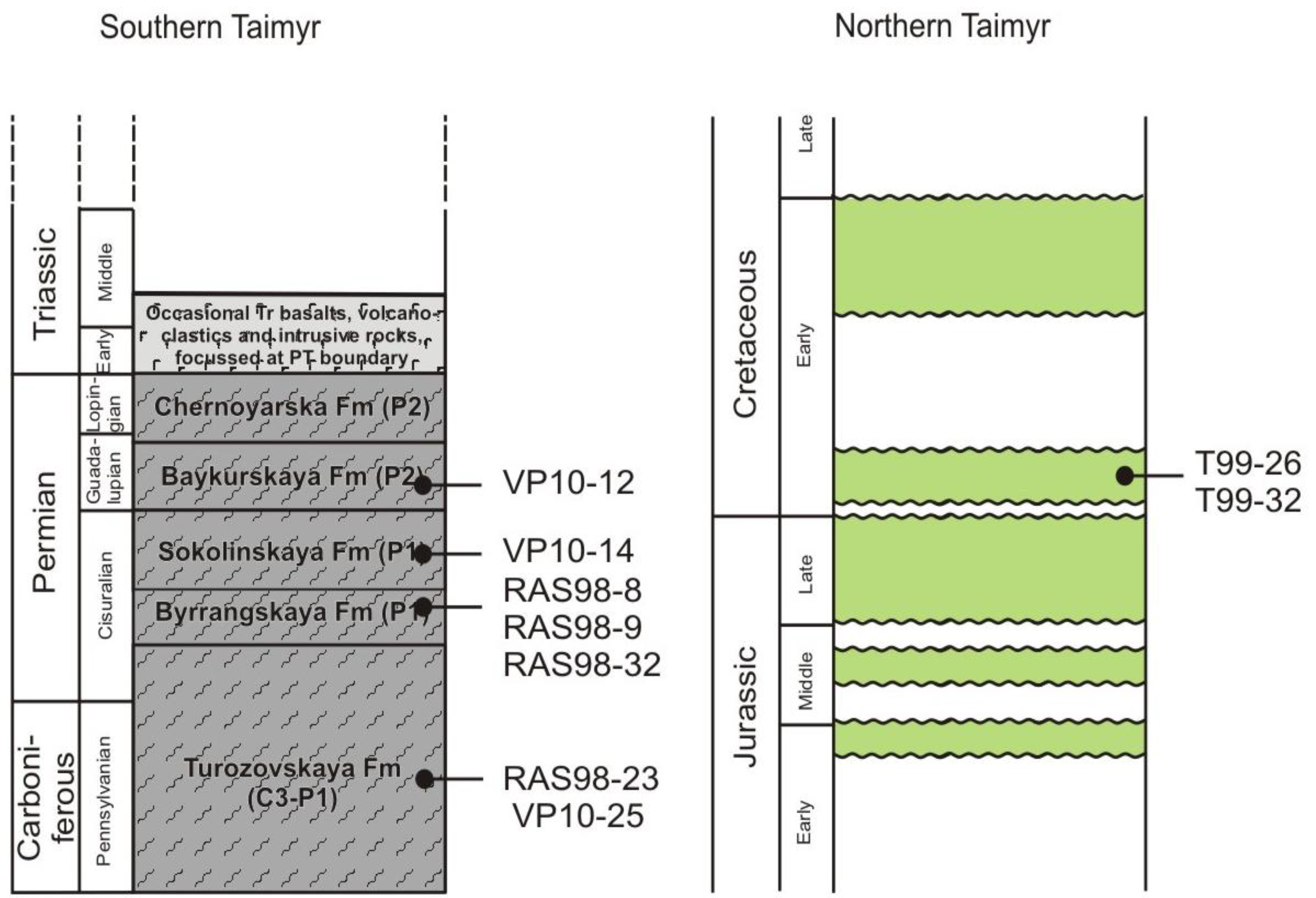
3.1. Petrography
3.2. Heavy Mineral Analysis
| Sample | Formation | Qm | Qp | P | K | Lv | Ls |
|---|---|---|---|---|---|---|---|
| T99-26 | Unnamed | 213 | 29 | 1 | 43 | 0 | 0 |
| T99-32 | Unnamed | 196 | 25 | 1 | 69 | 0 | 0 |
| RAS98-8 | Byrrangskaya | 184 | 40 | 4 | 0 | 0 | 52 |
| RAS98-9 | Byrrangskaya | 135 | 32 | 10 | 10 | 1 | 33 |
| RAS98-32 | Byrrangskaya | 84 | 46 | 21 | 15 | 5 | 38 |
| RAS98-23 | Turozovskya | 117 | 64 | 31 | 6 | 3 | 44 |
| VP10-12 | Baykurskaya | 195 | 65 | 45 | 20 | 90 | 70 |
| VP10-14 | Sokolinskaya | 230 | 55 | 75 | 40 | 25 | 40 |
| VP10-25 | Turozovskya | 295 | 60 | 60 | 10 | 30 | 10 |
3.3. Detrital Zircon Geochronology
| Samples | T99-26 | T99-32 | RAS98-8 | RAS98-9 | RAS98-23 | VP10-12 | VP10-14 | VP10-25 |
|---|---|---|---|---|---|---|---|---|
| Formation | Unnamed | Unnamed | Byrrangskaya | Byrrangskaya | Turozovskya | Baykurskaya | Sokolinskaya | Turozovskya |
| Heavy mineral assemblages | ||||||||
| apatite | 1 | 9 | 41 | 159 | 163 | 79 | 99 | 58 |
| tourmaline | 14 | 36 | 162 | 138 | 49 | 61 | 39 | 25 |
| zircon | 52 | 64 | 200 | 28 | 114 | 30 | 192 | 109 |
| garnet | 45 | 39 | 7 | 3 | 7 | 50 | 15 | 7 |
| hornblende | 0 | 0 | 0 | 0 | 1 | 19 | 8 | 8 |
| rutile | 7 | 16 | 23 | 6 | 11 | 18 | 17 | 36 |
| chloritoid | 0 | 0 | 24 | 0 | 0 | 23 | 13 | 7 |
| monazite | 0 | 2 | 0 | 0 | 5 | 12 | 21 | 10 |
| staurolite | 347 | 256 | 0 | 0 | 0 | 16 | 7 | 8 |
| epidote | 4 | 10 | 0 | 7 | 0 | 44 | 29 | 9 |
| titanite | 1 | 5 | 10 | 0 | 12 | 4 | 19 | 6 |
| sillimanite | 0 | 0 | 0 | 2 | 1 | 0 | 3 | 2 |
| chrome spinel | 0 | 0 | 6 | 0 | 7 | 0 | 0 | 0 |
| Total | 471 | 437 | 473 | 343 | 370 | 356 | 462 | 285 |
| Heavy mineral ratios | ||||||||
| apatite-tourmaline (ATi) | 27 | 21 | 20 | 54 | 77 | 54 | 72 | 70 |
| total | 44 | 95 | 203 | 297 | 214 | 100 | 200 | 83 |
| garnet-zircon (GZi) | 49 | 43 | 3 | 5 | 6 | 63 | 7 | 6 |
| total | 238 | 231 | 207 | 86 | 121 | 80 | 207 | 116 |
| monazite-zircon (MZi) | 0 | 2 | 0 | 0 | 4 | 26 | 10 | 6 |
| total | 122 | 133 | 200 | 82 | 119 | 47 | 200 | 100 |
4. Results
4.1. Petrography
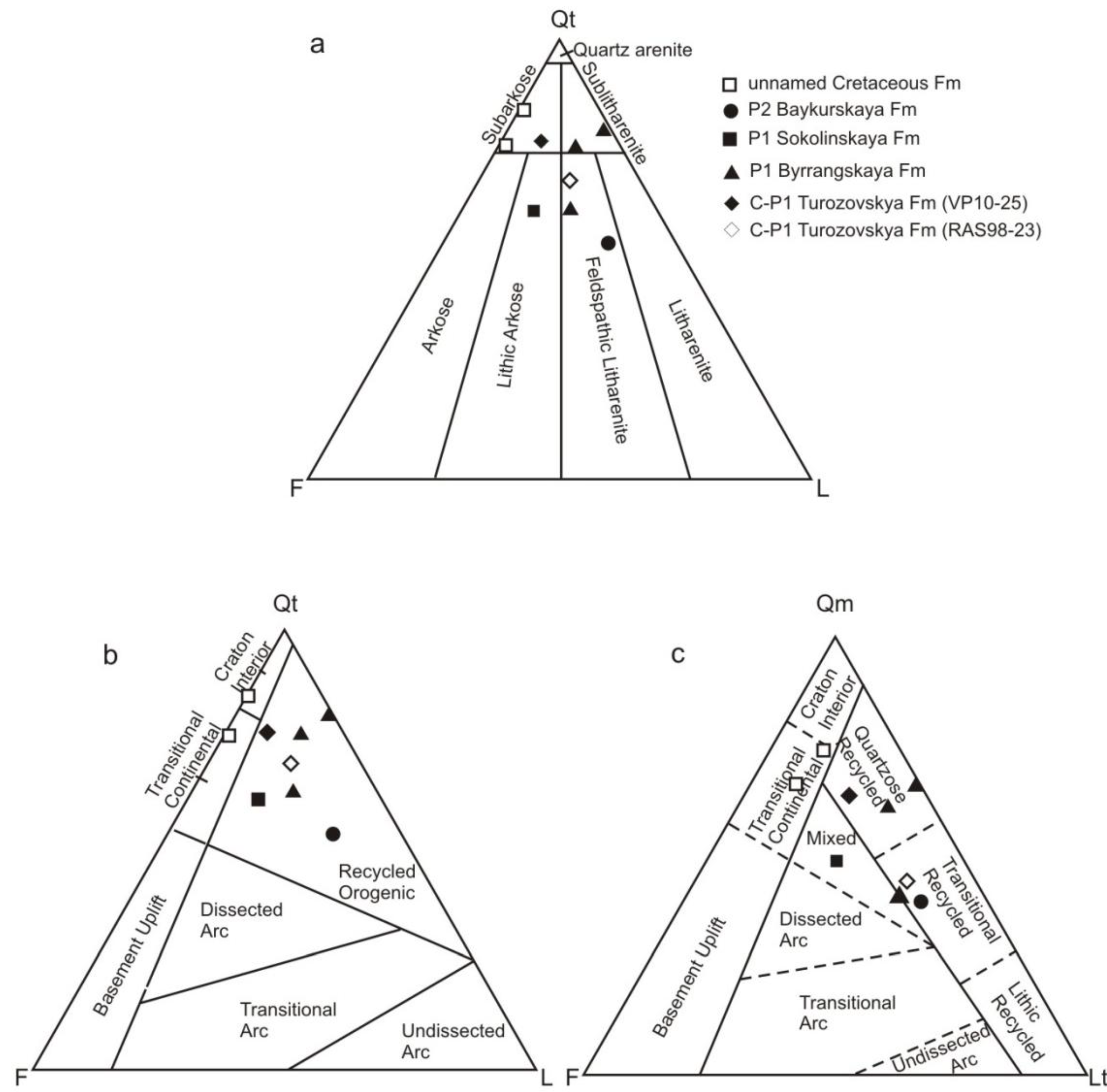
4.2. Heavy Mineral Results
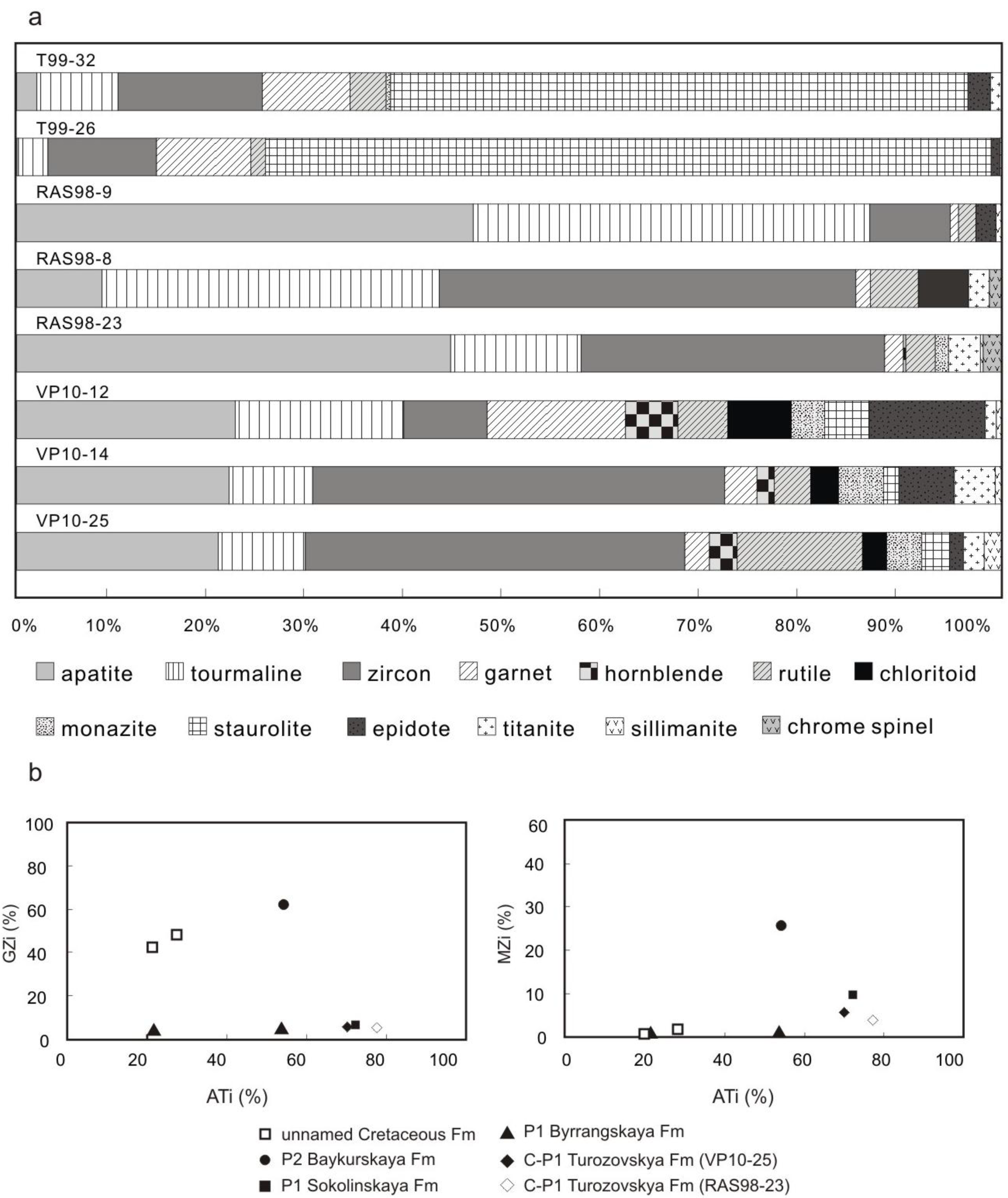
4.3. Zircon Geochronology Results
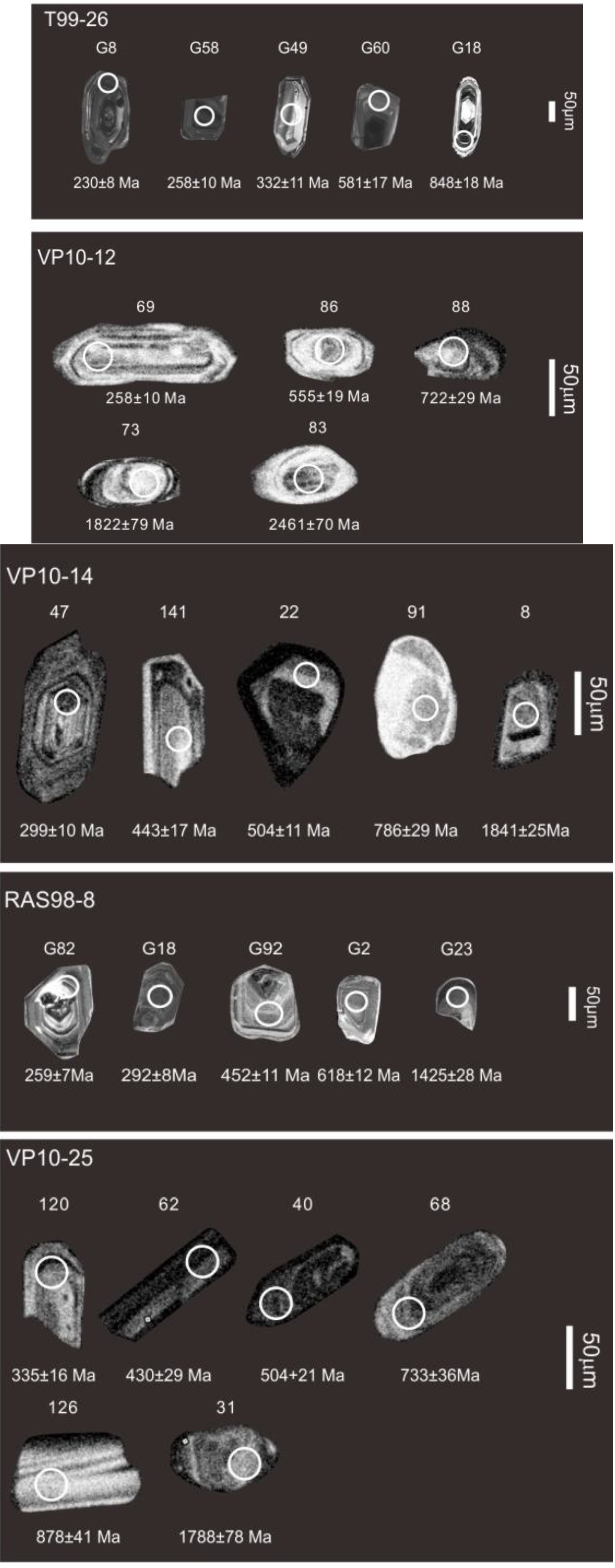


5. Discussion
5.1. Provenance of Permo-Carboniferous and Early Cretaceous Successions
5.2. Uralian Orogeny vs. Mesozoic Folding and Thrusting
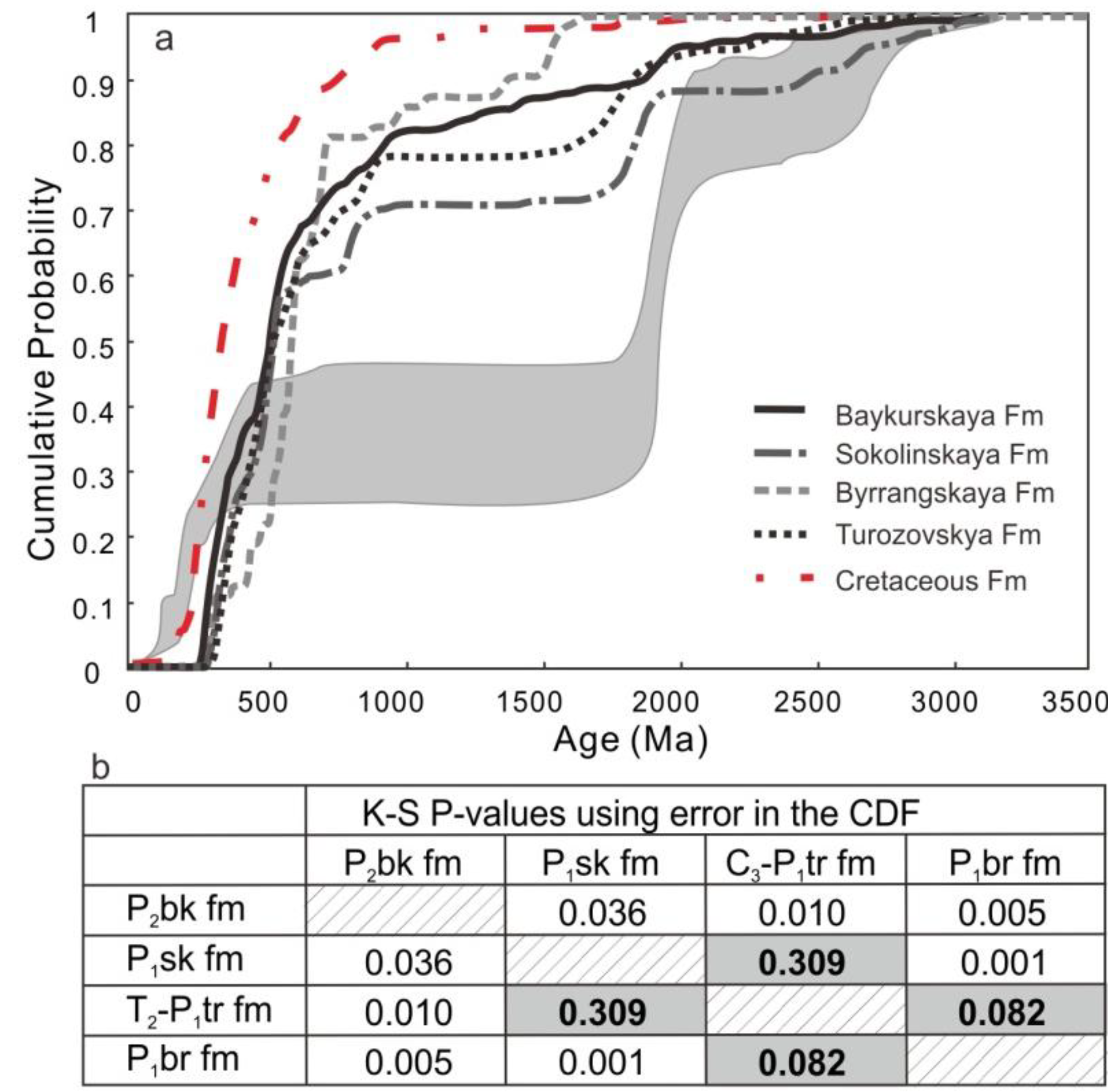
5.3. Tectonic Setting of Taimyr in the Cretaceous
6. Conclusions
- The Permo-Carboniferous successions were deposited in a foreland basin of the Uralian Orogen, consistent with the northwards continuation of the Urals into Taimyr. The final collision between Baltica and Siberia in the latest stage of Uralian orogenesis occurred in the late Permian, as recorded by the dramatic change in provenance associated with late Permian sandstone.
- Early Cretaceous sediments in northern Taimyr are proximal and have significant input from Siberian trap-related magmatism found in and near the Taimyr Peninsula. Cretaceous sediment provenance suggests deposition in a rift or passive margin setting and is unrelated to Jura-Cretaceous crustal shortening and arc collision associated with the Verkhoyansk Fold Belt. Consequently, a Cretaceous passive margin setting seems likely.
Acknowledgements
Conflict of Interest
References
- Zonenshain, L.; Korinevsky, V.; Kazmin, V.; Pechersky, D.; Khain, V.; Matveenkov, V. Plate tectonic model of the South Urals development. Tectonophysics 1984, 109, 95–135. [Google Scholar] [CrossRef]
- Hamilton, W. The Uralides and the motion of the Russian and Siberian platforms. Geol. Soc. Am. Bull. 1970, 81, 2553–2576. [Google Scholar] [CrossRef]
- Brown, D.; Spadea, P.; Puchkov, V.; Alvarez-Marron, J.; Herrington, R.; Willner, A.P.; Hetzel, R.; Gorozhanina, Y.; Juhlin, C. Arc–continent collision in the Southern Urals. Earth Sci. Rev. 2006, 79, 261–287. [Google Scholar] [CrossRef]
- Shipilov, E.; Vernikovsky, V. The Svalbard–Kara plates junction: Structure and geodynamic history. Russ. Geol. Geophys. 2010, 51, 58–71. [Google Scholar] [CrossRef]
- Miller, E.L.; Soloviev, A.V.; Prokopiev, A.V.; Toro, J.; Harris, D.; Kuzmichev, A.B.; Gehrels, G.E. Triassic river systems and the paleo-Pacific margin of northwestern Pangea. Gondwana Res. 2012, 23, 1631–1645. [Google Scholar]
- Nikishin, A.; Ziegler, P.; Stephenson, R.; Cloetingh, S.; Furne, A.; Fokin, P.; Ershov, A.; Bolotov, S.; Korotaev, M.; Alekseev, A. Late Precambrian to Triassic history of the East European Craton: Dynamics of sedimentary basin evolution. Tectonophysics 1996, 268, 23–63. [Google Scholar] [CrossRef]
- Lawver, L.A.; Grantz, A.; Gahagan, L.M. Plate kinematic evolution of the present Arctic region since the Ordovician. Geol. Soc. Am. Spec. Pap. 2002, 360, 333–358. [Google Scholar]
- Drachev, S.S. Tectonic setting, structure and petroleum geology of the Siberian Arctic offshore sedimentary basins. Geol. Soc. Lond. Mem. 2011, 35, 369–394. [Google Scholar] [CrossRef]
- Pease, V. Eurasian orogens and Arctic tectonics: An overview. Geol. Soc. Lond. Mem. 2011, 35, 311–324. [Google Scholar] [CrossRef]
- Otto, S.; Bailey, R. Tectonic evolution of the northern Ural Orogen. J. Geol. Soc. 1995, 152, 903–906. [Google Scholar] [CrossRef]
- Korago, E.A.; Kovaleva, G.N.; Lopatin, B.G.; Orgo, V.V. The precambrian rocks of Novaya Zemlya. Geol. Soc. Lond. Mem. 2004, 30, 135–143. [Google Scholar] [CrossRef]
- O’leary, N.; White, N.; Tull, S.; Bashilov, V.; Kuprin, V.; Natapov, L.; Macdonald, D. Evolution of the Timan–Pechora and south barents sea basins. Geol. Mag. 2004, 141, 141–160. [Google Scholar] [CrossRef]
- Puchkov, V. Tectonics of the Urals: Modern concepts. Geotectonics 1997, 31, 294–312. [Google Scholar]
- Gee, D.G.; Bogolepova, O.K.; Lorenz, H. The Timanide, Caledonide and Uralide orogens in the Eurasian high Arctic, and relationships to the palaeo-continents Laurentia, Baltica and Siberia. Geol. Soc. Lond. Mem. 2006, 32, 507–520. [Google Scholar] [CrossRef]
- Scott, R.A.; Howard, J.P.; Guo, L.; Schekoldin, R.; Pease, V. Offset and curvature of the Novaya Zemlya fold-and-thrust belt, Arctic Russia. Pet. Geol. Conf. Ser. 2010, 7, 645–657. [Google Scholar]
- Drachev, S.S.; Malyshev, N.A.; Nikishin, A.M. Tectonic history and petroleum geology of the Russian Arctic Shelves: An overview. Pet. Geol. Conf. Ser. 2010, 7, 591–619. [Google Scholar]
- Sengör, A.; Natal’in, B.; Burtman, V. Evolution of the Altaid tectonic collage and Paleozoic crustal growth in Eurasia. Nature 1993, 364, 299–307. [Google Scholar] [CrossRef]
- International Bathymetric Chart of the Arctic Ocean (IBCAO) database Home Page. Available online: http://www.ngdc.noaa.gov/mgg/bathymetry/arctic/-arctic.html (accessed on 25 July 2013).
- Bezzubtsev, V.; Malitch, N.; Markov, F.; Pogrebitsky Yu, E. Geological Map of Mountainous Taimyr 1: 500,000, Ministry of Geology of the USSR; [in Russian]; Ministry of Geology of the Russian Federation (RSFSR), Krasnoyarskgeologia: Krasnoyarsk, Russian, 1983.
- Inger, S.; Scott, R.; Golionko, B. Tectonic evolution of the Taimyr Peninsula, northern Russia: Implications for Arctic continental assembly. J. Geol. Soc. 1999, 156, 1069–1072. [Google Scholar] [CrossRef]
- Walderhaug, H.; Eide, E.; Scott, R.; Inger, S.; Golionko, E. Palaeomagnetism and 40Ar/39Ar geochronology from the South Taimyr igneous complex, Arctic Russia: A Middle–Late Triassic magmatic pulse after Siberian flood-basalt volcanism. Geophys. J. Int. 2005, 163, 501–517. [Google Scholar] [CrossRef]
- Lorenz, H.; Gee, D.G.; Whitehouse, M.J. New geochronological data on Palaeozoic igneous activity and deformation in the Severnaya Zemlya Archipelago, Russia, and implications for the development of the Eurasian Arctic margin. Geol. Mag. 2007, 144, 105–125. [Google Scholar] [CrossRef]
- Lorenz, H.; Männik, P.; Gee, D.; Proskurnin, V. Geology of the Severnaya Zemlya Archipelago and the North Kara Terrane in the Russian high Arctic. Int. J. Earth Sci. 2008, 97, 519–547. [Google Scholar] [CrossRef]
- Pease, V.; Scott, R.A. Crustal affinities in the Arctic Uralides, northern Russia: Significance of detrital zircon ages from Neoproterozoic and Palaeozoic sediments in Novaya Zemlya and Taimyr. J. Geol. Soc. 2009, 166, 517–527. [Google Scholar] [CrossRef]
- Gee, D.G.; Pease, V. The Neoproterozoic Timanide Orogen of Eastern Baltica; Geological Society Publishing House: London, UK, 2004. [Google Scholar]
- Lorenz, H.; Gee, D.G.; Larionov, A.N.; Majka, J. The Grenville–Sveconorwegian orogen in the high Arctic. Geol. Mag. 2012, 149, 875–891. [Google Scholar] [CrossRef]
- Dobretsov, N.; Vernikovsky, V. Mantle plumes and their geologic manifestations. Int. Geol. Rev. 2001, 43, 771–787. [Google Scholar] [CrossRef]
- Reichow, M.K.; Pringle, M.; Al’Mukhamedov, A.; Allen, M.; Andreichev, V.; Buslov, M.; Davies, C.; Fedoseev, G.; Fitton, J.; Inger, S. The timing and extent of the eruption of the Siberian Traps large igneous province: Implications for the end-Permian environmental crisis. Earth Planet. Sci. Lett. 2009, 277, 9–20. [Google Scholar] [CrossRef]
- Nikishin, A.; Ziegler, P.; Abbott, D.; Brunet, M.-F.; Cloetingh, S. Permo–Triassic intraplate magmatism and rifting in Eurasia: Implications for mantle plumes and mantle dynamics. Tectonophysics 2002, 351, 3–39. [Google Scholar] [CrossRef]
- Saunders, A.D.; England, R.W.; Reichow, M.K.; White, R.V. A mantle plume origin for the Siberian traps: uplift and extension in the West Siberian Basin, Russia. Lithos 2005, 79, 407–424. [Google Scholar] [CrossRef]
- Torsvik, T.H.; Andersen, T.B. The Taimyr fold belt, Arctic Siberia: Timing of prefold remagnetisation and regional tectonics. Tectonophysics 2002, 352, 335–348. [Google Scholar] [CrossRef]
- Miller, E.L.; Soloviev, A.; Kuzmichev, A.; Gehrels, G.; Toro, J.; Tuchkova, M. Jurassic and Cretaceous foreland basin deposits of the Russian Arctic: Separated by birth of the Makarov Basin? Norw. J. Geol. 2008, 88, 201–226. [Google Scholar]
- Vernikovsky, V. The geodynamic evolution of the Taimyr folded area. Geol. Pac. Ocean 1996, 12, 691–704. [Google Scholar]
- Bezzubtsev, V.; Zalyaleyev, R.; Sakovich, A. Geological Map of Mountainous Taimyr 1: 500,000: Explanatory Notes; [in Russian]; Ministry of Geology of the Russian Federation (RSFSR), Krasnoyarskgeologia: Krasnoyarsk, Russian, 1986.
- Zonenshain, L.; Kuzmin, M.; Natapov, L. Geology of the USSR: A Plate-Tectonic Synthesis (American Geophysical Union, Geodynamics Series), 21; American Geophysical Union: Washington, DC, USA, 1990. [Google Scholar]
- Uflyand, A.; Natapov, L.; Lopatin, V.; Chernov, D. On the Taimyr tectonic nature. Geotectonics 1991, 6, 76–79. [Google Scholar]
- Vernikovsky, V.; Vernikovskaya, A.; Pease, V.; Gee, D. Neoproterozoic orogeny along the margins of Siberia. Geol. Soc. Lond. Mem. 2004, 30, 233–248. [Google Scholar] [CrossRef]
- Pease, V.; Gee, D.G.; Vernikovsky, V.; Vernikovskaya, A.; Kireev, S. Geochronological evidence for late-Grenvillian magmatic and metamorphic events in central Taimyr, northern Siberia. Terra Nova 2001, 13, 270–280. [Google Scholar] [CrossRef]
- Vernikovsky, V.; Neimark, L.; Ponomarchuk, V.; Vernikovskaya, A.; Kireev, A.; Kuz’Min, D. Geochemistry and age of collision granitoides and metamorphites of the Kara microcontinent (Northern Taimyr). Russ. Geol. Geophys. 1995, 36, 46–60. [Google Scholar]
- Vernikovsky, V.; Sal’nikova, E.; Kotov, A.; Ponomarchuk, V.; Kovach, V.; Travin, A.; Yakovleva, C.; Berezjnava, N. Age of post-collisional granitoids of Northern Taimyr: U-Pb, Sm-Nd, Rb-Sr, and Ar-Ar dat. Dokl. RAN 1998, 363, 375–378. [Google Scholar]
- Pease, V.; Department of Geological Sciences, Stockholm University, Stockholm, Sweden. unpublished work.
- Natapov, L.M.; Paraketsov, K.V.; Kulikova, L.I.; Kononov, M.N. Jurassic-Cretaceous Tectonostratigraphy of Northern Russia. CASP Rep. Arct. Russ. Stud. Reg. Arct. Proj. 1997, 663, 146–150. [Google Scholar]
- Dickinson, W.R.; Beard, L.; Brakenridge, G.R.; Erjavec, J.L.; Ferguson, R.C.; Inman, K.F.; Knepp, R.E.X.A.; Lindberg, F.; Ryberg, P.T. Provenance of North American Phanerozoic sandstones in relation to tectonic setting. Bull. Geol. Soc. Am. 1983, 94, 222–235. [Google Scholar] [CrossRef]
- Mange, M.A.; Maurer, H.F. Heavy Minerals in Colour; Chapman & Hall: London, UK, 1992; Volume 147, p. 145. [Google Scholar]
- Morton, A.C.; Berge, C. Heavy mineral suites in the Statfjord and Nansen Formations of the Brent Field, North Sea; A new tool for reservoir subdivision and correlation. Pet. Geosci. 1995, 1, 355–364. [Google Scholar] [CrossRef]
- Galehouse, J.S. Point Counting. In Procedures in Sedimentary Petrology; Wiley-Interscience: New York, NY, USA, 1971; pp. 385–407. [Google Scholar]
- Sláma, J.; Kosler, J.; Condon, D.J.; Crowley, J.L.; Gerdes, A.; Hanchar, J.M.; Horstwood, M.S.A.; Morris, G.A.; Nasdala, L.; Norberg, N.; et al. Plesovice zircon—A new natural reference material for U-Pb and Hf isotopic microanalysis. Chem. Geol. 2008, 249, 1–35. [Google Scholar] [CrossRef]
- Paces, J.B.; Miller, J.D. Precise U-Pb ages of Duluth Complex and related mafic intrusions, northeastern Minnesota: Geochronological insights to physical, petrogenetic, paleomagnetic, and tectonomagmatic processes associated with the 1.1 Ga Midcontinent Rift System. J. Geophys. Res. Solid Earth 1993, 98, 13997–14013. [Google Scholar] [CrossRef]
- Hellstrom, J.; Paton, C.; Woodhead, J.; Hergt, J. Iolite: Software for spatially resolved LA-(quad and MC) ICPMS analysis. Mineral. Assoc. Can. Short Course Ser. 2008, 40, 343–348. [Google Scholar]
- Paton, C.; Hellstrom, J.; Paul, B.; Woodhead, J.; Hergt, J. Iolite: Freeware for the visualisation and processing of mass spectrometric data. J. Anal. Atom. Spectrom. 2011, 26, 2508–2518. [Google Scholar] [CrossRef]
- Petrus, J.A.; Kamber, B.S. VizualAge: A novel approach to laser ablation ICP-MS U-Pb geochronology data reduction. Geostand. Geoanal. Res. 2012, 3, 247–270. [Google Scholar] [CrossRef]
- Pearce, N.J.G.; Perkins, W.T.; Westgate, J.A.; Gorton, M.P.; Jackson, S.E.; Neal, C.R.; Chenery, S.P. A compilation of new and published major and trace element data for NIST SRM 610 and NIST SRM 612 glass reference materials. Geostand. Newslett. 1997, 21, 115–144. [Google Scholar] [CrossRef]
- Lugwig, K. Isoplot/Ex Version 4.1, a Geochronological Toolkit for Microsoft Excel; Berkeley Geochronology Center Special Publication: Berkeley, CA, USA, 2010; p. No. 4. [Google Scholar]
- Smyth, H.R.; Hall, R.; Nichols, G.J. Significant volcanic contribution to some quartz-rich sandstones, east Java, indonesia. J. Sediment. Res. 2008, 78, 335–356. [Google Scholar] [CrossRef]
- Folk, R.L. Petrology of Sedimentary Rocks, 2nd ed.; Hemphill Press: Austin, TX, USA, 1974. [Google Scholar]
- Dickinson, W.R.; Suczek, C.A. Plate tectonics and sandstone compositions. Am. Assoc. Pet. Geol. Bull. 1979, 63, 2164–2182. [Google Scholar]
- Deer, W.A.; Howie, R.A. An Introduction to the Rock-Forming Minerals; Longman: New York, NY, USA, 1966. [Google Scholar]
- Morton, A.C.; Hallsworth, C.R. Processes controlling the composition of heavy mineral assemblages in sandstones. Sediment. Geol. 1999, 124, 3–29. [Google Scholar] [CrossRef]
- Morton, A.C.; Hallsworth, C. Identifying provenance-specific features of detrital heavy mineral assemblages in sandstones. Sediment. Geol. 1994, 90, 241–256. [Google Scholar] [CrossRef]
- Gehrels, G. Detrital zircon U-Pb geochronology: Current methods and new opportunities. In Tectonics of Sedimentary Basins: Recent Advances; Busby, C., Pérez Azor, A., Eds.; John Wiley & Sons: Hoboken, NJ, USA, 2011; pp. 45–62. [Google Scholar]
- Gehrels, G. Analysis Tools. Available online: http://www.geo.arizona.edu/alc/Analysis%20Tools.htm (accessed on 25 July 2013).
- Corfu, F.; Hanchar, J.M.; Hoskin, P.W.O.; Kinny, P. Atlas of zircon textures. Rev. Mineral. Geochem. 2003, 53, 469–500. [Google Scholar] [CrossRef]
- Prokopiev, A.V.; Toro, J.; Miller, E.L.; Gehrels, G.E. The paleo–Lena River—200 m.y. of transcontinental zircon transport in Siberia. Geology 2008, 36, 699–702. [Google Scholar] [CrossRef]
- Bea, F.; Fershtater, G.; Montero, P. Granitoids of the Uralides: Implications for the evolution of the orogen. Geophys. Monogr. Ser. 2002, 132, 211–232. [Google Scholar] [CrossRef]
- Scarrow, J.; Hetzel, R.; Gorozhanin, V.; Dinn, M.; Glodny, J.; Gerdes, A.; Ayala, C.; Montero, P. Four decades of geochronological work in the southern and middle Urals: A review. Geophys. Monogr. Ser. 2002, 132, 233–255. [Google Scholar] [CrossRef]
- Brown, D.; Puchkov, V.; Alvarez-Marron, J.; Bea, F.; Perez-Estaun, A. Tectonic processes in the Southern and Middle Urals: An overview. Geol. Soc. Lond. Mem. 2006, 32, 407–419. [Google Scholar] [CrossRef]
- Görz, I.; Buschmann, B.; Kroner, U.; Hauer, R.; Henning, D. The Permian emplacement of granite–gneiss complexes in the East Uralian Zone and implications on the geodynamics of the Uralides. Tectonophysics 2009, 467, 119–130. [Google Scholar] [CrossRef]
- Marello, L.; Ebbing, J.; Gernigon, L. Basement inhomogeneities and crustal setting in the Barents Sea from a combined 3D gravity and magnetic model. Geophys. J. Int. 2013, 193, 557–584. [Google Scholar] [CrossRef]
- Lorenz, H.; Gee, D.G.; Simonetti, A. Detrital zircon ages and provenance of the Late Neoproterozoic and Palaeozoic successions on Severnaya Zemlya, Kara Shelf: A tie to Baltica. Norw. J. Geol. 2008, 88, 235–258. [Google Scholar]
- Miller, E.; Gehrels, G.; Pease, V.; Sokolov, S. Stratigraphy and U-Pb detrital zircon geochronology of Wrangel Island, Russia: Implications for Arctic paleogeography. AAPG Bull. 2010, 94, 665–692. [Google Scholar] [CrossRef]
- Willner, A.P.; Sindern, S.; Metzger, R.; Ermolaeva, T.; Kramm, U.; Puchkov, V.; Kronz, A. Typology and single grain U/Pb ages of detrital zircons from Proterozoic sandstones in the SW Urals (Russia): Early time marks at the eastern margin of Baltica. Precambrian Res. 2003, 124, 1–20. [Google Scholar] [CrossRef]
- Pease, V.; Persson, S. Neoproterozoic Island Arc Magmatism of Northern Taimyr. In Proceedings of the Fourth International Conference on Arctic MarginsUS Department of the InteriorMinerals Management Service OCS Study, Anchorage, AK, USA, October 2006; pp. 31–49.
- Glodny, J.; Pease, V.; Montero, P.; Austrheim, H.; Rusin, A. Protolith ages of eclogites, Marun-Keu Complex, Polar Urals, Russia: Implications for the pre-and early Uralian evolution of the northeastern European continental margin. Geol. Soc. Lond. Mem. 2004, 30, 87–105. [Google Scholar] [CrossRef]
- Metelkin, D.V.; Vernikovsky, V.A.; Kazansky, A.Y.; Bogolepova, O.K.; Gubanov, A.P. Paleozoic history of the Kara microcontinent and its relation to Siberia and Baltica: Paleomagnetism, paleogeography and tectonics. Tectonophysics 2005, 398, 225–243. [Google Scholar] [CrossRef]
- Kuzmichev, A.B.; Pease, V.L. Siberian trap magmatism on the New Siberian Islands: Constraints for Arctic Mesozoic plate tectonic reconstructions. J. Geol. Soc. 2007, 164, 959–968. [Google Scholar] [CrossRef]
- Vernikovsky, V.A.; Pease, V.L.; Vernikovskaya, A.E.; Romanov, A.P.; Gee, D.G.; Travin, A.V. First report of early Triassic A-type granite and syenite intrusions from Taimyr: Product of the northern Eurasian superplume? Lithos 2003, 66, 23–36. [Google Scholar] [CrossRef]
- Massey, F.J., Jr. The Kolmogorov-Smirnov test for goodness of fit. J. Am. Statist. Assoc. 1951, 46, 68–78. [Google Scholar] [CrossRef]
- Glebovsky, V.; Kaminsky, V.; Minakov, A.; Merkur’ev, S.; Childers, V.; Brozena, J. Formation of the Eurasia Basin in the Arctic Ocean as inferred from geohistorical analysis of the anomalous magnetic field. Geotectonics 2006, 40, 263–281. [Google Scholar] [CrossRef]
- Malyshev, N.; Nikishin, V.; Nikishin, A.; Obmetko, V.; Martirosyan, V.; Kleshchina, L.; Reydik, Y.V. A New Model of the Geological Structure and Evolution of the North Kara Sedimentary Basin. Doklady Earth Sci. 2012, 445, 791–795. [Google Scholar] [CrossRef]
- Cawood, P.A.; Hawkesworth, C.J.; Dhuime, B. Detrital zircon record and tectonic setting. Geology 2012, 40, 875–878. [Google Scholar] [CrossRef] [Green Version]
- Grantz, A.; Hart, P.E.; Childers, V.A. Chapter 50 Geology and tectonic development of the Amerasia and Canada Basins, Arctic Ocean. Geol. Soc. Lond. Mem. 2011, 35, 771–799. [Google Scholar] [CrossRef]
- Miller, E.L.; Toro, J.; Gehrels, G.; Amato, J.M.; Prokopiev, A.; Tuchkova, M.I.; Akinin, V.V.; Dumitru, T.A.; Moore, T.E.; Cecile, M.P. New insights into Arctic paleogeography and tectonics from U-Pb detrital zircon geochronology. Tectonics 2006, 25. [Google Scholar] [CrossRef]
- Amato, J.M.; Toro, J.; Miller, E.L.; Gehrels, G.E.; Farmer, G.L.; Gottlieb, E.S.; Till, A.B. Late Proterozoic–Paleozoic evolution of the Arctic Alaska–Chukotka terrane based on U-Pb igneous and detrital zircon ages: Implications for Neoproterozoic paleogeographic reconstructions. Geol. Soc. Am. Bull. 2009, 121, 1219–1235. [Google Scholar] [CrossRef]
© 2013 by the authors; licensee MDPI, Basel, Switzerland. This article is an open access article distributed under the terms and conditions of the Creative Commons Attribution license (http://creativecommons.org/licenses/by/3.0/).
Share and Cite
Zhang, X.; Omma, J.; Pease, V.; Scott, R. Provenance of Late Paleozoic-Mesozoic Sandstones, Taimyr Peninsula, the Arctic. Geosciences 2013, 3, 502-527. https://doi.org/10.3390/geosciences3030502
Zhang X, Omma J, Pease V, Scott R. Provenance of Late Paleozoic-Mesozoic Sandstones, Taimyr Peninsula, the Arctic. Geosciences. 2013; 3(3):502-527. https://doi.org/10.3390/geosciences3030502
Chicago/Turabian StyleZhang, Xiaojing, Jenny Omma, Victoria Pease, and Robert Scott. 2013. "Provenance of Late Paleozoic-Mesozoic Sandstones, Taimyr Peninsula, the Arctic" Geosciences 3, no. 3: 502-527. https://doi.org/10.3390/geosciences3030502




